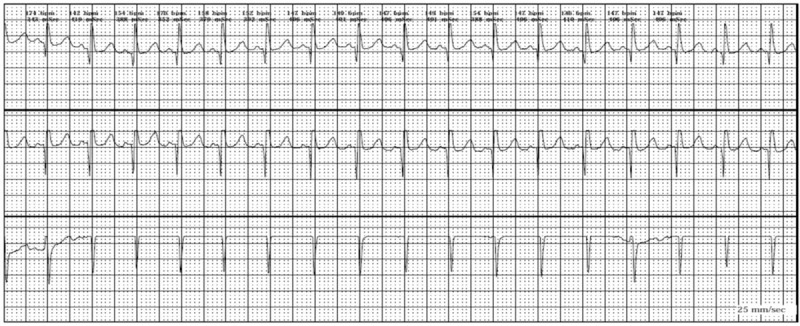Playlist
Show Playlist
Hide Playlist
Cardiac Case: 18-year-old Woman with Fast Heart Beat and Shortness of Breath
-
Cardiac Case 18-year-old Woman with Fast Heart Beat and Shortness of Breath.pdf
-
Reference List Cardiology.pdf
-
Download Lecture Overview
00:01 An 18-year-old woman is brought to the emergency department because the patient noted that her heart was beating very fast and she was somewhat short of breath. 00:09 In the emergency department, the heart rate was noted to be 220/min which is very fast and her blood pressure was reduced to 84/60 mmHg. 00:19 The rest of the physical exam was normal as were all blood tests. 00:22 What's important in the history here of course is palpitations suggesting an arrhythmia, as well as some shortness of breath, and of course, very impressive tachycardia, and also borderline severe hypotension. 00:36 She gets -- had had an ECG done several weeks ago in the cardiology department and it showed the Wolff-Parkinson-White syndrome. 00:46 The characteristic of this syndrome are first of all, there's an up-sloping R wave in lead V5 that's due to the bypass track causing abnormal conduction pattern in the ventricle - we'll show you an example of that in greater detail in a moment - and also, a very short PR interval because the bypass track doesn't have the delay of the AV node so very rapidly after the atrial depolarization, you start to see ventricular depolarization. 01:17 And the diagnosis she was known to have: Wolff-Parkinson-White. 01:20 So here's a little more enlargement of that. First of all, you see the PR interval is quite short. 01:26 Why? Well, that's a normal atrial activation but before the impulse can get into the ventricular from the AV node, it short circuits through the little bypass track which is left over from embryonic life but the conduction isn't normal so you see there's sort of a slowed upstroke, the so-called 'delta wave'. 01:44 So, the short PR interval in the delta wave are characteristic of an accessory bypass track that's left over from embryonic life and shouldn't be there. 01:54 And here we see her emergency room ECG going pretty fast, right? What's interesting is that even though she's going very fast, her QRS is still narrow. 02:04 It tells you that this is a young, healthy heart: short PR interval, narrow QRS, very rapid heart rate. 02:10 Diagnosis: supraventricular tachycardia. 02:14 She's given intravenous procainamide in the emergency room and converts to normal sinus rhythm. 02:20 She's sent to see a cardiac electrophysiologist or we lovingly call them 'my cardiac electricians' and she has an ablation of the bypass track. 02:31 Her ECG becomes normal and she should have no further problems. 02:35 I joke with my residents that this is the only heart disease we cure. 02:38 Every other heart disease, we're very effective at palliating it making the patient do better but we don't cure it. This heart disease, we actually cure. 02:48 Just a little diagram to show you, here's the normal electrical pathways in the heart and here you could see there's the normal electrical pathways but on the right atrium, there's a little tiny green arrow. 03:01 There's a little bypass track there that enables the electrical activity to get into the ventricular early as a secondary entrance and that causes the delta wave. 03:12 So, you see here just to orient you, there's the sinus node, there's the AV node, and the accessory track results in some conduction into the ventricle in the right atrium area and you can see that that causes the delta wave.
About the Lecture
The lecture Cardiac Case: 18-year-old Woman with Fast Heart Beat and Shortness of Breath by Joseph Alpert, MD is from the course Cardiovascular Cases.
Included Quiz Questions
An 18-year-old woman presents to the emergency department because she noted that her heart was beating "very fast" and that she was short of breath. In the emergency department, her heart rate was 220 beats/min and her blood pressure was 84/60 mmHg. The rest of the physical examination findings were normal, as were all blood test results. A few weeks ago, she received a diagnosis of Wolff–Parkinson–White syndrome. Which of the following ECG findings would be consistent with this diagnosis?
- Delta waves
- Wide QRS complex
- T-wave inversion
- Significant Q waves
- Long PR interval
An 18-year-old woman presents to the emergency department because she noted that her heart was beating "very fast" and that she was short of breath. Prior to presentation, her heart rate was 220 beats/min, and her blood pressure was 84/60 mm Hg. The rest of the physical examination findings were normal, as were all blood test results. A few weeks ago, she has received a diagnosis of Wolf–Parkinson–White syndrome. An ECG taken at the emergency department reveals normal sinus rhythm. Which of the following is the best next step in management?
- Electrophysiology consultation for ablation
- Class II antiarrhythmic
- Direct current cardioversion
- Class I antiarrhythmic
- Implantation of biventricular pacemaker
Customer reviews
5,0 of 5 stars
| 5 Stars |
|
5 |
| 4 Stars |
|
0 |
| 3 Stars |
|
0 |
| 2 Stars |
|
0 |
| 1 Star |
|
0 |




